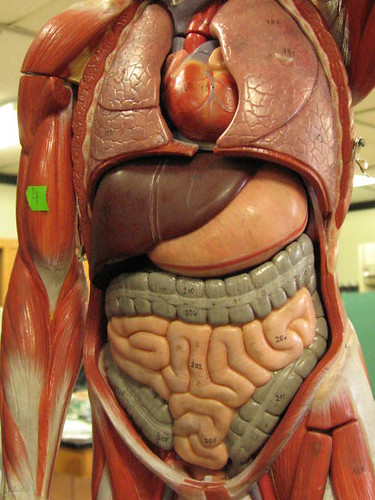| Share Presentation: https://NeoK12.com/pres/ZDIGSYS1 | |
|
The Digestive System From Mouth to Stomach
All humans, like animals, need food to survive. Humans need food to survive, and this food becomes fuel for the body. This process is called digestion. There are 4 main parts to our digestive system:
The mouth is where digestion begins. When we take a bite of food, we chew it into small pieces. Our teeth bite, grind and rip the food. The muscles of our mouth and tongue move the food and mix it with the saliva in our mouth. Saliva is a watery substance that our mouth secretes to aid digestion. One of the most important jobs of saliva is to break down starchy food (like pasta and bread) into simple sugars.
| ||||
|
Next.......
We swallow the chewed food and it continues on its path to the stomach. The food is pushed down the esophagus by involuntary muscles. The stomach is less than 2 feet below the mouth, and when it is empty, it is the size of your fist.
The stomach is very strong and acts like a washing machine. The muscular lining squeezes and churns the food to break it down into a liquid. The stomach adds special chemicals that are very acidic (full of acid). The acid helps break down food fast. Food stays in the stomach for 3-6 hours, and by the time it is ready to leave the stomach, it is a very thick liquid.
| ||||
|
After several hours in the stomach, food is only partially digested. Next it moves to the small intestine. The small intestine gets its name because it is small in diameter. But the small intestine is 25 feet long-it fits into our body because it is coiled up like a sleeping snake.
Chemicals, called enzymes, enter the small intestine to help break down the food even more. These enzymes come from 2 important organs-the liver and the pancreas. The nutrients from food are broken down and absorbed by the walls of the small intestine. From there, they move into the bloodstream, and the nutrients are carried to all parts of the body. The small intestine is where most of our food's nutrients are made usuable to the body. | ||||
|
The Large Intestine
From the small intestine, what is left of our meal passes to the large intestine. The large intestine is short-it is only about 5 feet long. The material that ends up in the large intestine is all undigestable. The main job of the largei ntestine is to take out minerals and the liquid from waste. The moisture is absorbed back into the body through the wall of the large intestine. After several hours, the waste is ready to leave the body. | ||||
|
From the Digestive System to the Excretory System
Toxins, or poisons, have no place in our bodies, so the human body has a way of eliminating these poisons from the body. This is through the excretory system. The main organs of this system are the kidneys and the large intestine.
The Kidneys
The kidneys are the main waste removal organs. Liquid waste is taken out of the blood through millions of tubes in the kidneys. Some of the clean water is then returned to our cells. The rest of the water holds waste particles. This liquid waste is called urine. Urine drains from the kidneys into the bladder. The bladder is like a balloon that can hold up to a pint of urine. Urine stays in the bladder until it is passed from the body. After the undigested food has passed into the large intestine, it has to be removed from the body. It is called solid waste at this point. Here, moisture is taken out of it. Finally, the waste is pushed out of the body through an opening at the end of the intestine. | ||||




